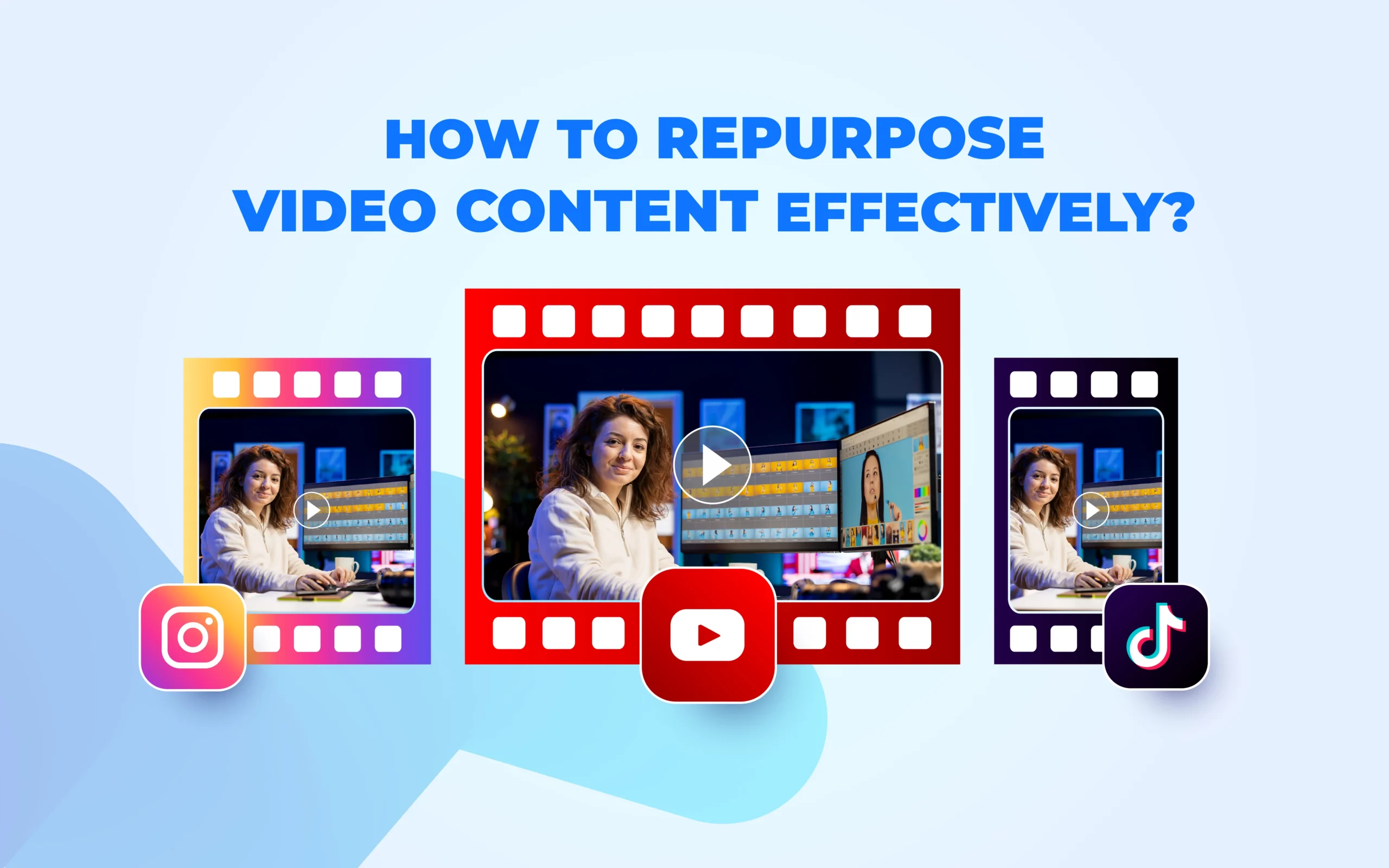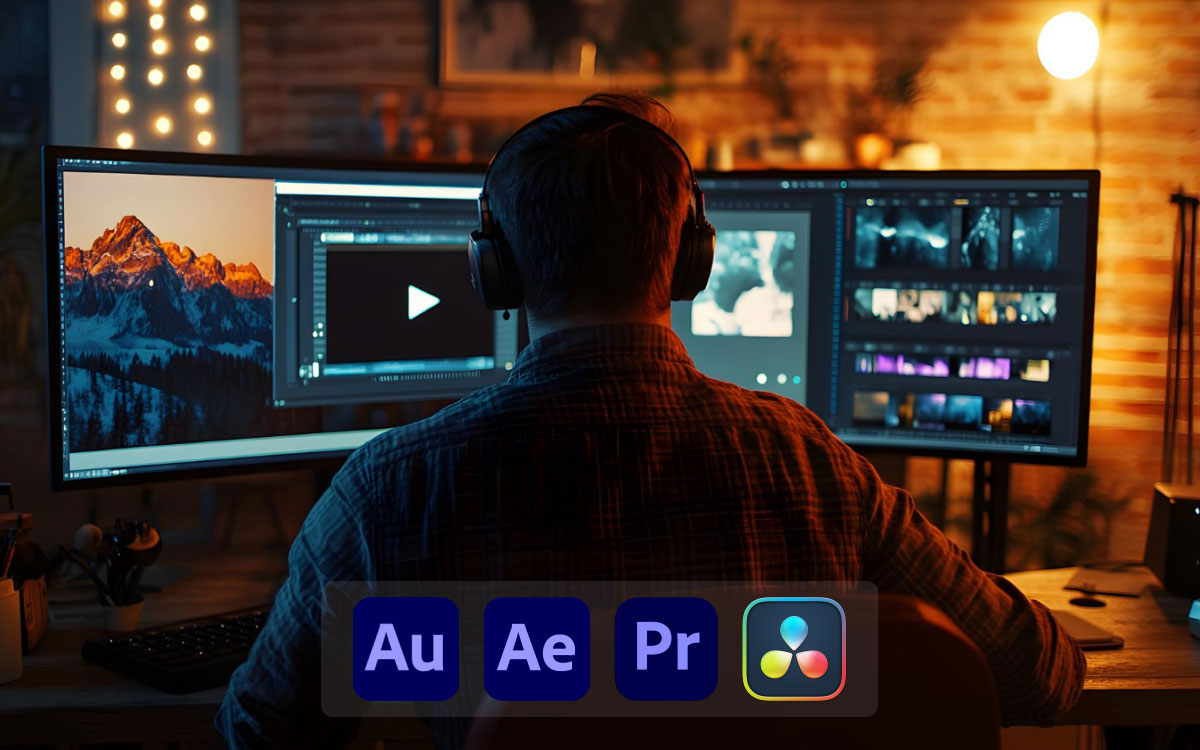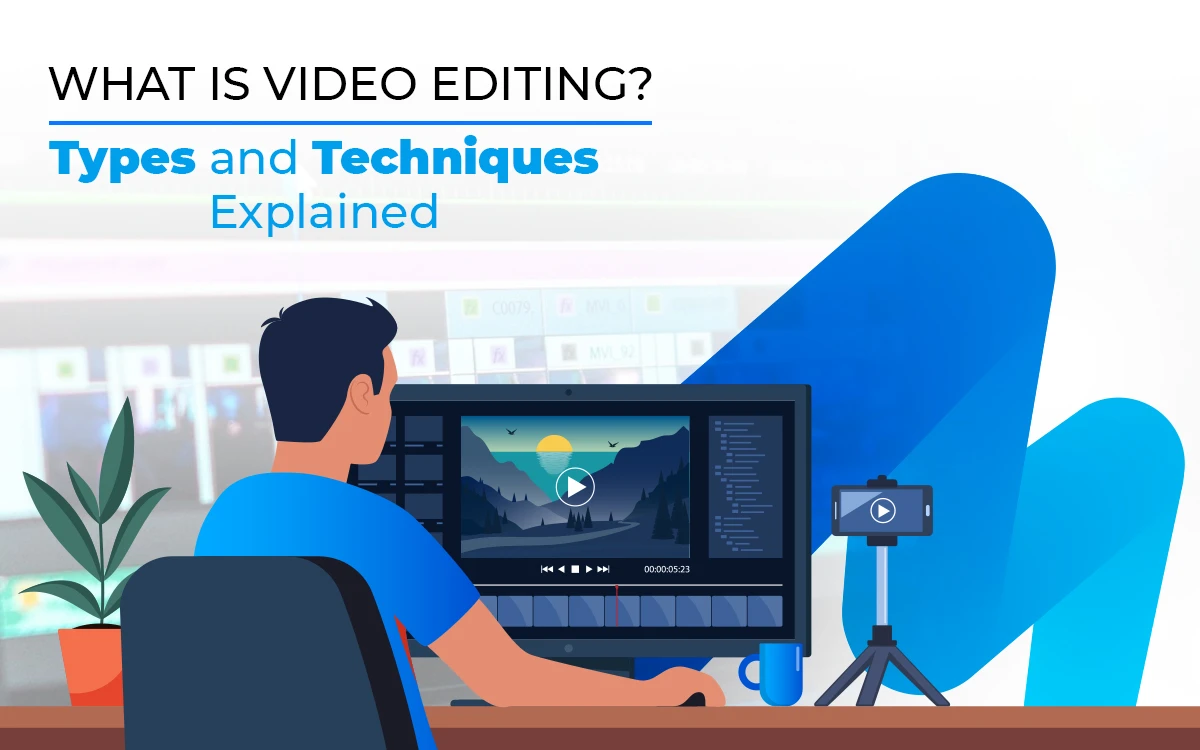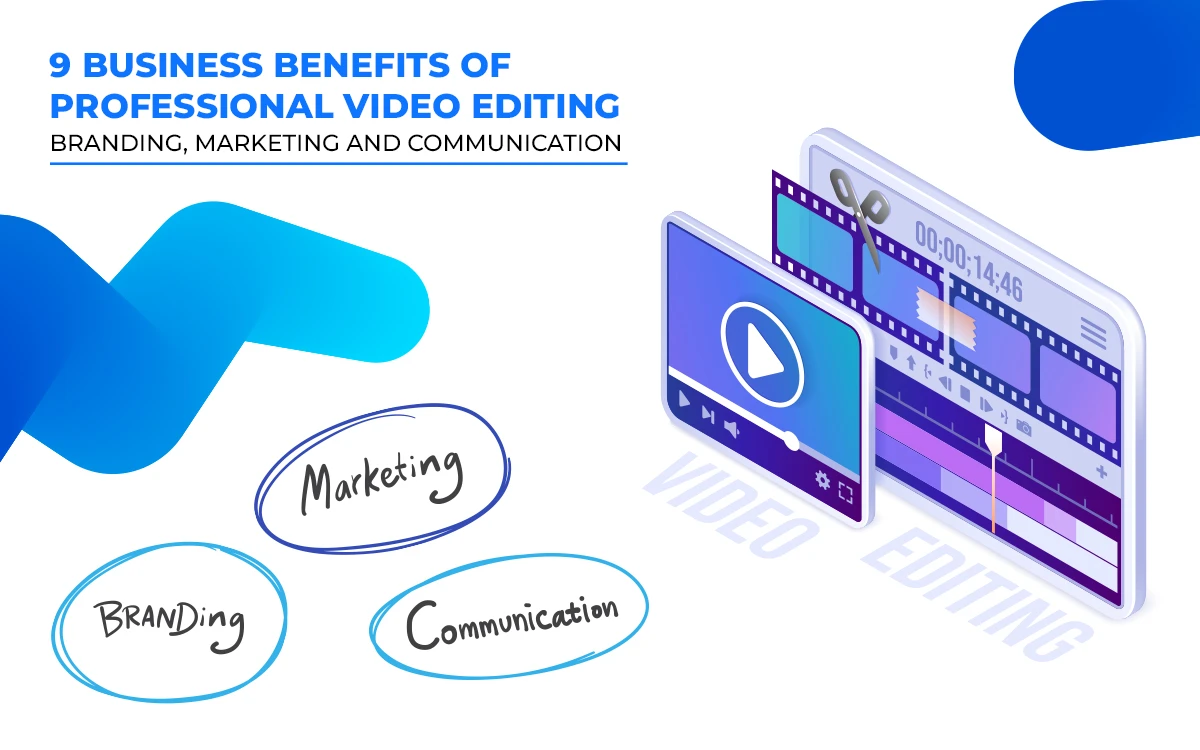To repurpose a video content effectively, you can extract short clips for reels, create snippets for social media story, convert it for step by step posts, or create blog posts around that video content. Repurposing video content improves SEO and brand visibility, save resources, and boost viewres’ engagement. Popular video repurposing software are Adobe Premiere Pro, Filmora, DaVinci Resolve, Final Cut Pro, and CapCut.
What you’ll learn in this article
- 1 Why Repurposing Video Content is Essential in 2025?
- 2 How to Repurpose YouTube Videos?
- 3 How to Repurpose E-commerce Product Videos for Social Ads?
- 4 How to Repurpose Corporate & Training Videos for Microlearning?
- 5 What are the Popular Tools and Techniques Used for Repurposing Videos?
- 6 What are the Best Practices for Repurposing Video Content?
- 7 FAQ’s Repurposing Video Content
Why Repurposing Video Content is Essential in 2025?
Repurposing video content is essential in 2025 because it extends existing content’s lifespan, converting business ROI, saving time, reducing production needs, and boosting engagement. Video repurposes drive higher traffic, build and expand brand mention and recall through augmented viewers’ engagement across different sales channels, such as e-commerce and social media. Other importances of video repurposing are as follows.
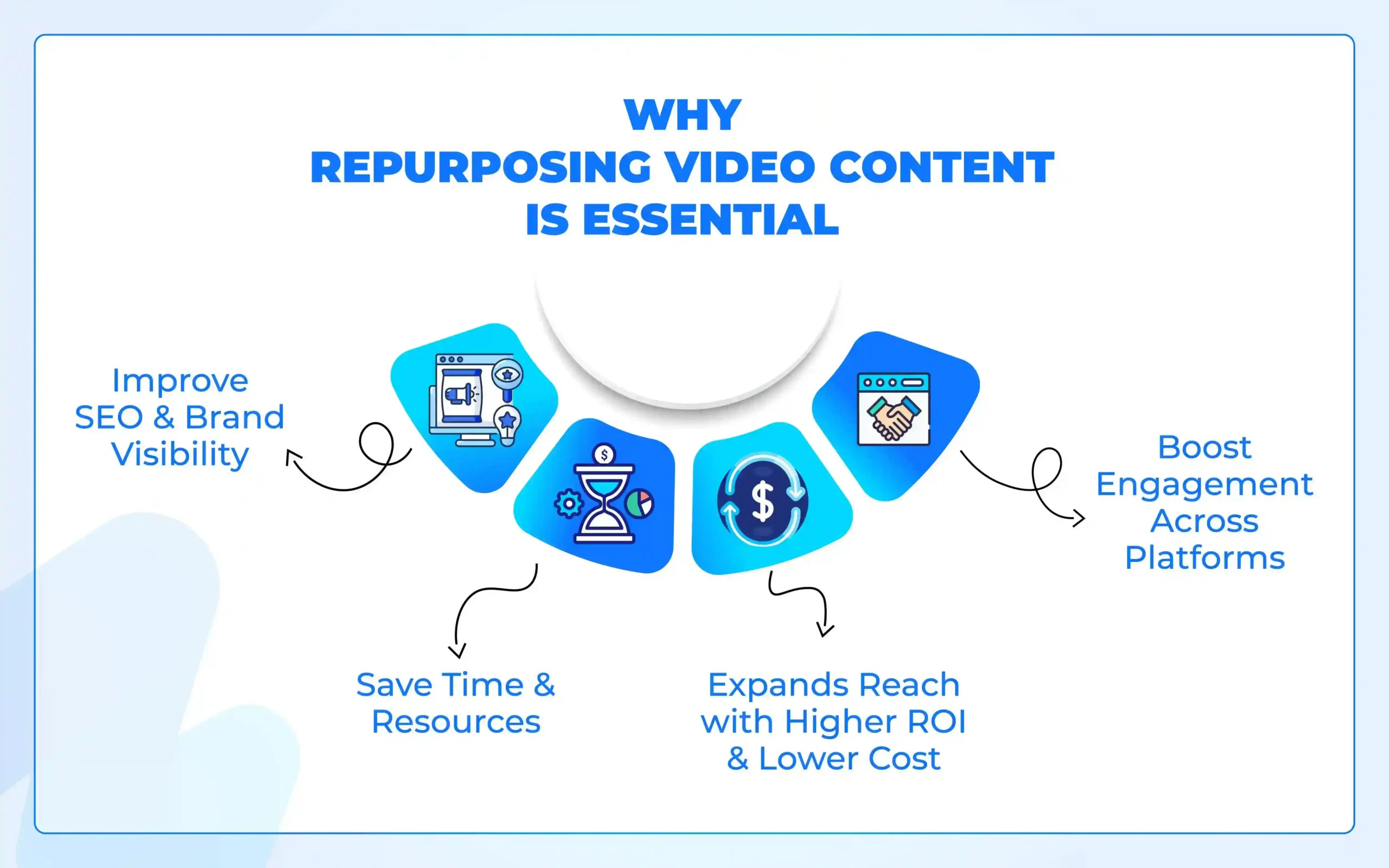
Improve SEO and Brand Visibility
Repurposed videos improve the company’s SEO approaches by reaching more touchpoints across social platforms. As the content reaches more areas, it gets more exposure to a vast audience, resulting in increasing organic discovery.
Save Time and Resources
Video repurposing saves time on creating brand-new videos on relevant topics by creating thumbnails, clips, etc. Strategic use of repurposed videos saves both time and cost for businesses. A 2025 blog by Intensify titled Content Repurposing Strategies: Get More Mileage Out of Your Best Assets has shared a survey report stating 65% marketers consented that content repurposing is affordable than creating new.
Expands Reach with Higher ROI & Lower Cost
Repurposing helps brands stretch and diversify existing video content to more platforms. Taking advantage of one video in multiple formats amplifies return, increases the audience, and keeps brands updated with trends.
Boost Engagement Across Platforms
Different video publishing platforms favor different formats and lengths for example, YouTube supports medium to long videos, TikTok and Instagram favor short-form video. Repurposing video content allows you to stay aligned with per-channel requirements with increased reach. In a 2025 blog by Teleprompter titled Video Marketing Statistics and Trends in 2025, they shared that people retain 95% of a message while watching a video, compared to only 10% from a text.
How to Repurpose YouTube Videos?
There are many ways to repurpose YouTube videos, which include extracting short clips for TikTok and reels, creating snippets for stories, turning tutorials into step-by-step posts, and transcribing and turning videos into blogs or newsletters. Repurposing focuses on the viewer’s demand and prolongs content relevance.
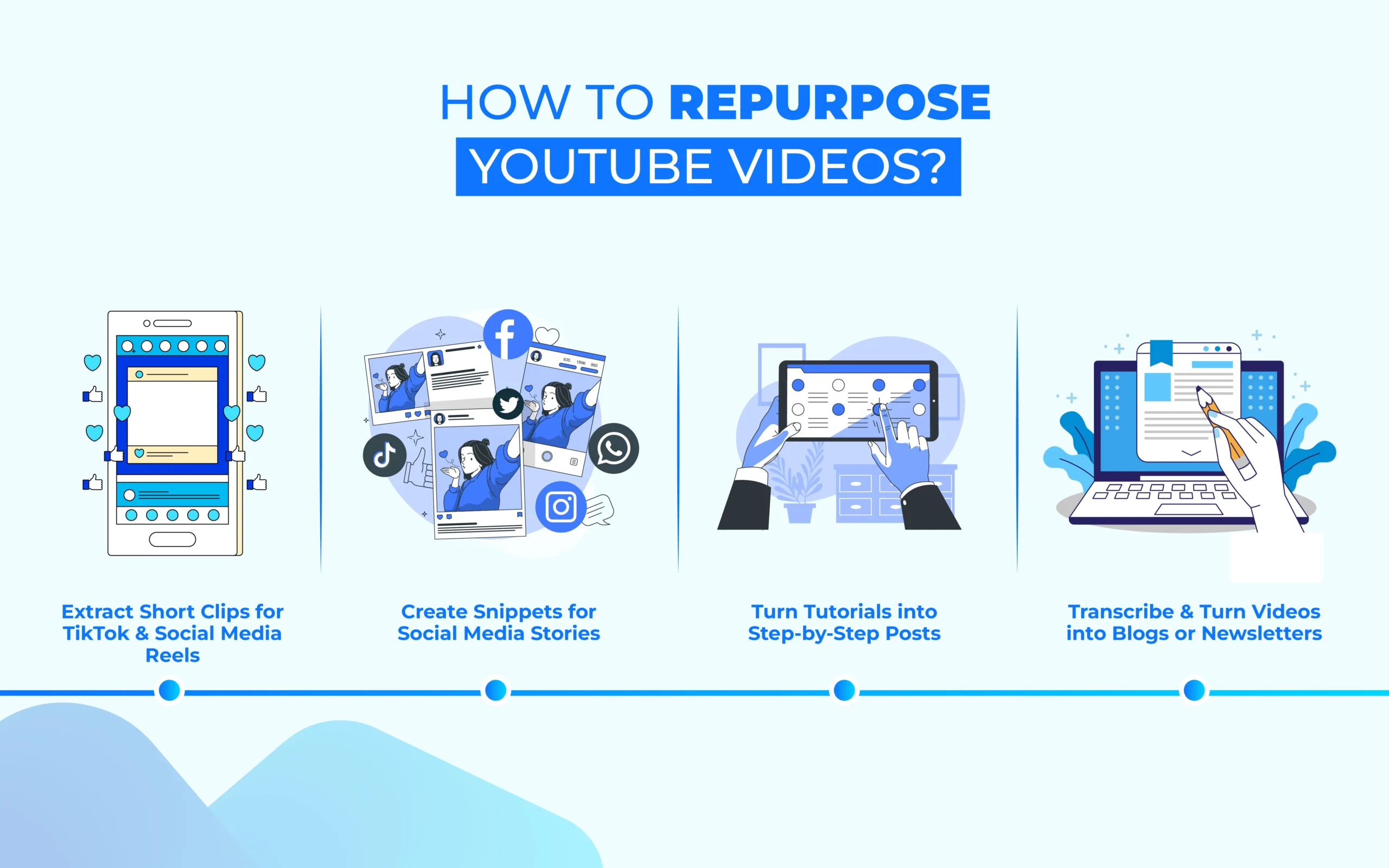
1. Extract Short Clips for TikTok & Social Media Reels
Step 1: Open your preferred video editing software and create a new vertical sequence (aspect ratio 9:16).
Step 2: Import the complete YouTube video file into the software timeline. Play through to find the hook or visual peaks to place markers.
Step 3: Trim a short clip around each marker. Now, Reposition to keep the subjects centered.
Step 4: Add captions, subtitles, or relevant text to use as a hook. Make sure the fonts are readable. Include 1-2 second branded logo, intro/outro if needed.
Step 5: Export the file into MP4/H.264 preset for mobile optimization.
2. Create Snippets for Social Media Stories
Step 1: Import the original video file into the video editing software and jump to the moment you want to extract as a 5-15 second snippet.
Step 2: Crop vertically and ensure all the text and visuals remain inside the “safe zone” (centered).
Step 3: Add burned-in captions or use auto-subtitles. Then, add simple motion text or stickers to grab attention, but keep the animation short.
Step 4: Rename it differently and export as a short file.
3. Turn Tutorials Into Step-By-Step Posts
Step 1: Open the video editing software and upload the video to your timeline.
Step 2: Add markers at each logical section in the tutorial. Cut a short clip for each step, around 30 seconds.
Step 3: Include text as title cards or lower-thirds of “Step 1” “Step 2”.
Step 4: Export each step in a short, single video. Also, export those videos in still frames for image carousels.
Step 5: Design carousel posts as per social platforms.
- Instagram: Create 1-2 images per step with short captions.
- LinkedIn: Change each step into a social post with the matching video.
Or, combine all clips into one stitched video of a “how-to” reel for quick tutorials.
4. Transcribe & Turn Videos Into Blogs or Newsletters
Step 1: Open the video editing software. Either export subtitles/captions (SRT/VTT), or use a transcription tool like Descript or Otter.
Step 2: Clean and organize the transcript in a text editor. Remove filler words, fix grammar, and add headings matching video chapters.
Step 3: Include a short intro, CTAs, and supporting resources. Convert timestamps into clickable links for easy navigation.
Step 4: Enrich the post with short video clips or still images from your original video.
Note: Before final production, check the content copyright, subject position in the center, readable caption, and CTAs.
How to Repurpose E-commerce Product Videos for Social Ads?
To repurpose e-commerce product videos for social ads, you can convert long demos into short ads within 30 seconds, use product angles for carousel videos, or create GIFs and motion graphics from video snippets.

1. Convert Long Demos Into 15-30 Second Ads
Step 1: Open video editing software, import and play through the video.
Step 2: Mark the compelling product features, benefits, impacting movements, and CTAs.
Step 3: Trim the videos within 10 to 30 seconds. Then, add captions, text overlays, or a logo along with the CTA.
Step 4: Export the short ad in the platforms’ preferred vertical or square format.
2. Use Product Angles for Carousel Videos
Step 1: Upload the video to your video editing tool. Identify the video portion that highlights product angles or details.
Step 2: Cut multiple short clips around 10 seconds so that each one covers one feature.
Step 3: Crop and reframe the landscape or square, considering the social platform’s carousel format.
Step 4: Export the videos separately as one and upload to Instagram or Facebook carousel ads.
3. Create GIFs and Motion Graphics from Video Snippets
Step 1: Open the video editing software and upload the targeted short video snippet.
Step 2: Add motion text, effects, and animated icons to emphasize the product.
Step 3: Export it to GIF or short MP4 clips. This will fit on website banners, email campaigns, or social posts.
How to Repurpose Corporate & Training Videos for Microlearning?
To repurpose corporate and training videos for microlearning visual assets, you can break webinars into themed lessons, add captions and quizzes, and convert them into animated explainer clips. Repurposing training and corporate videos into easy-to-consume content increases viewers’ retention rate.

1. Break Webinars into Themed Lessons
After uploading the video and identifying key segments, cut the video into theme-based, short, and focused sections. Add intro cards or titles for each lesson to introduce the topic. Once done, export each segment as a single video.
2. Add Captions and Quizzes for Engagement
Generate subtitles or captions after uploading the video to the editing software. Based on the support of the publishing platform, use overlays or interactive elements to insert knowledge checks or questions at key moments. Add readable captions and time-synchronization for clear delivery and export.
3. Convert into Animated Explainer Clips
After uploading a video and deciding on the explaining process section. Add animation, icons, graphics, effects motion texts to highlight key points do not overwhelm the visuals. Simplify the narration and export as short videos suitable for microlearning purposes on social media, internal portals, or learning management systems (LMS).
What are the Popular Tools and Techniques Used for Repurposing Videos?
The popular video editing tools used for repurposing videos include DaVinci Resolve, Filmora, Adobe Premiere Pro, Adobe Express, Final Cut Pro, and CapCut. These are professional-grade editing solutions that large-scale video production companies, video editing agencies use. AI tools and mobile apps offer fast and easy editing, but commercial-standard video production and repurposing rely on video editing software.
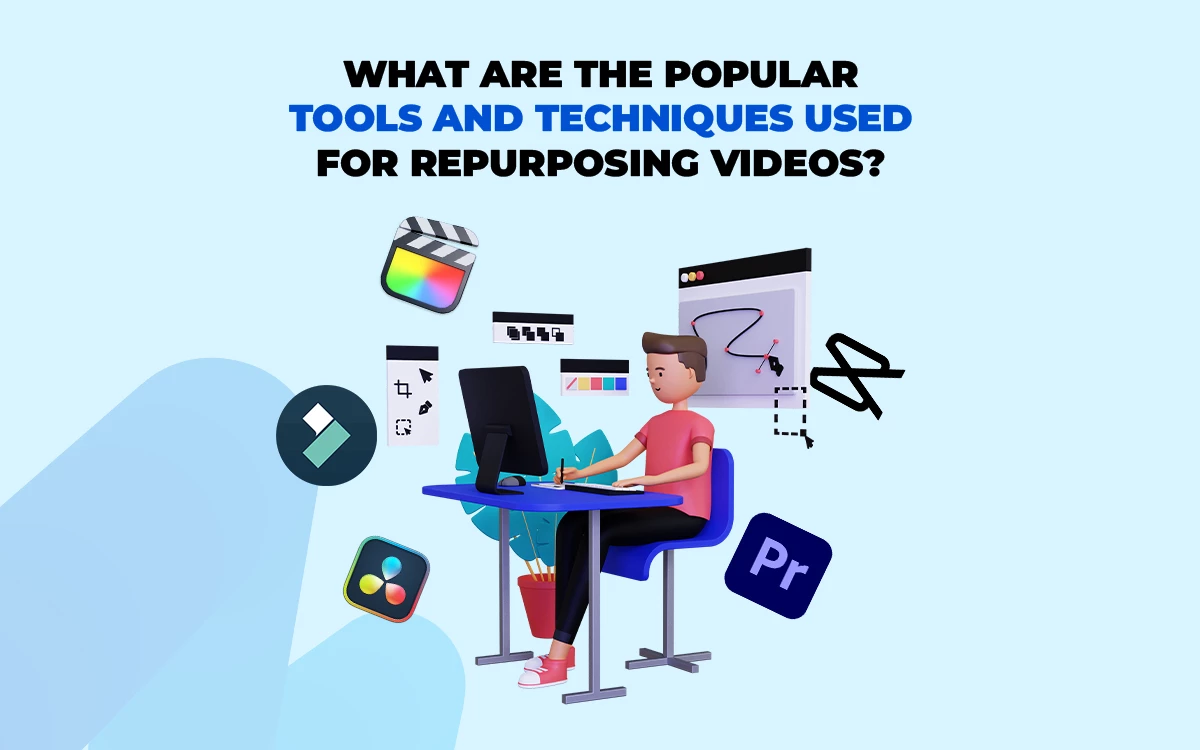
1. Adobe Premiere Pro
Adobe Premiere Pro is an industry-grade video editing platform that is used in media industries, advertising, and corporate industries. It is feature-rich and versatile, and supports integration with Adobe suites, allowing brands and businesses to create scalable video repurposing for campaigns.
Repurposing Features
- Export presets optimized for YouTube, TikTok, and Instagram
- Auto-reframe for multiple social platforms
- Seamless timeline-based clip trimming
- Motion graphics
2. Filmora
Filmora is beginner-friendly editing software that non-technical users, new content creators, small and medium businesses, and digital marketers use. This intuitive drag-and-drop interface allows creating fast and professional video editing to repurpose.
Repurposing Features
- Templates for quick content repurposing
- One-click aspect ratio conversion
- Built-in social media export presets
- Motion text and overlays for engagement
3. DaVinci Resolve
DaVinci Resolve is a professional editing and color grading tool that Social media content creators and TV studios use. Its advanced features include combining editing, color adjustment, and audio engineering in one platform. It is a cost-efficient solution for professionals looking to create cinematic-quality repurposing.
Repurposing Features
- Smart reframe for vertical and horizontal formats
- Precise color grading
- Batch exporting
- AI cut detection
4. Final Cut Pro
Apple’s flagship video editing software, Final Cut Pro is widely used by Mac users and creative professionals. It is reputed for advanced tools, speedy solutions, and optimized performance, which assist media, film, and content creation.
Repurposing Features
- Smart Conform for automatic aspect ratio changes
- Multicam support for repurposing interviews/events
- Export settings tailored for social platforms
- Magnetic timeline for efficient editing
5. CapCut
CapCut is a free, mobile-first video editing app that global influencers, social media managers, and solopreneurs use. For offering creative effects and templates, it has become a top choice for non-professionals.
Repurposing Features
- Auto-captions and subtitles
- Templates based on trending formats
- One-tap export to TikTok/Instagram
- AI background remover for versatile clips
What are the Best Practices for Repurposing Video Content?
There are 7 primary best practices for repurposing video content, which are optimizing video length, adapting platform-specific measurements, adding interactive elements, evaluating video analytics data, extracting segments for evergreen content creation, changing thumbnails and titles, and localizing videos for maximizing reach.
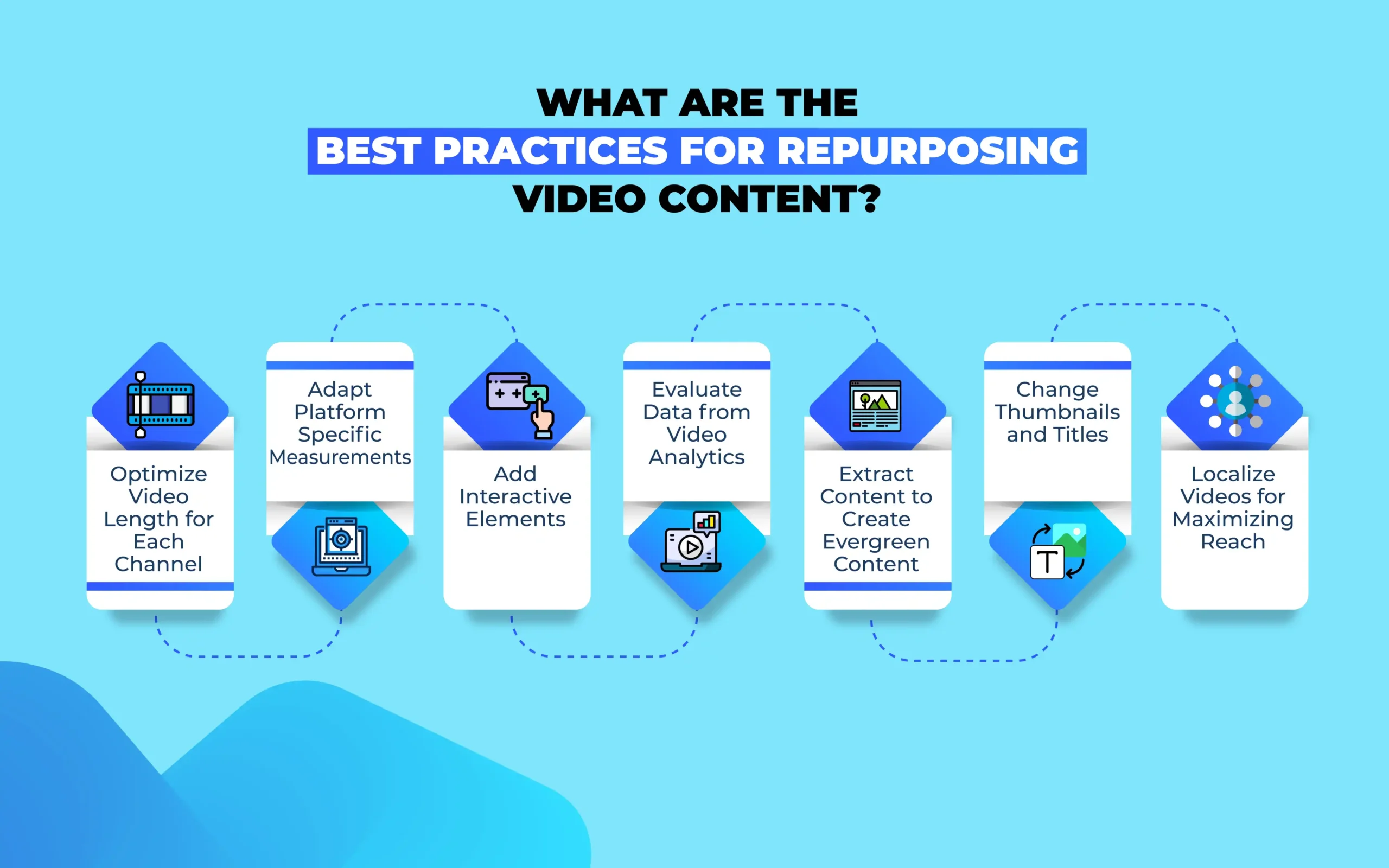
Optimize Video Length for Each Channel
Preferred video length differs across all platforms for example, Instagram and TikTok reward short-form videos around 30 seconds, whereas Facebook supports short to mid-length videos, and YouTube prefers mid-length to long format videos (8 to 15 minutes). Optimizing video length based on content, viewers’ preferences, and platforms’ algorithms will increase viewers’ engagement and watching rate.
Adapt Platform-Specific Measurements
When repurposing videos for different platforms, reformat the essential parts into horizontal (16:9) for YouTube, square (1:1) for Instagram feeds, vertical (9:16) for TikTok and Facebook reels, and shorts. Stick to the aspect ratio and resolution of each channel so that cropping issues don’t appear and content looks consistent and professional, both on desktop and mobile.
Add Interactive Elements
Add captions, subtitles, and interactive elements to effectively convey context. Most of the social media video viewers watch content on mute, so using visually interactive and text elements such as polls, end-screen CTAs would help viewers understand the topic better, improving the retention rate.
Evaluate Data from Video Analytics
Check and analyze the social media metrics such as views, engagement rate, number of traffic, etc, to see the audience retention graph. Scrutinizing viewers’ behavior on the video, where they drop off, and which videos have the most viewers. Edit the strong segment to reconnect with purpose.
Extract Content to Create Evergreen Content
Create a theme or topic-based reorganization for the trimmed footage. It enhances content longevity and creates binge-worthy micro content that increases viewers’ session duration. These types of videos get search engines’ priority, discoverability, and viewers’ preference.
Change Thumbnails and Titles
Refresh the existing thumbnails with bold text, a clear branded image, and elements. Include SEO-friendly titles, strong keywords, and emotional hooks. Making platform-adjusted changes on the repurposed videos creates a brand-new and click-worthy look, attracting new viewers.
Localize Videos for Maximizing Reach
To maximize repurposed videos’ reach, add voice-over, multilingual subtitles, regional CTAs, etc. When localized, these videos expand into new markets and target audiences, proving relevant for global viewers’ engagement.
FAQ’s Repurposing Video Content
Can I repurpose a video for multiple platforms without losing quality?
Yes, you can repurpose videos across platforms without losing quality by following best practices. Start editing with the highest-quality and best resolution files (for example, 4K or 1080p). While trimming and optimizing, consider the platform’s favoured aspect ratio and measurements (square, horizontal, vertical, etc). Before uploading, use the right compression for fast loading.
What’s the best way to cut long videos into engaging clips?
The best way to cut long video content into engaging clips is to use content mapping techniques. Determine the key parts to repurpose from the video and cut it into a bite-sized video. Use different video editing techniques, for example, jump cuts to remove pauses, captions or zoom-ins to hold attention, narrative-driven editing for delivering value, and CTA.
How often should I repurpose videos vs create new content?
The timeline when you should repurpose videos vs create new content depends on your goals, how the videos performed, and the statistics of viewers’ engagement. The frequency of video content creation and repurposing should follow the 20/80 rule, coined by Derek Halpern. 20% of the time for content creation and 80% of the time for promotion.
Repurposing is a form of promotion to connect viewers in different ways. However, a healthy business practice is to blend both repurposing and creation of video content if you have ample budget, time, and resources. Focus mostly on repurposing, as it lengthens content relevance, existence, and increases engagement.
Are there AI tools to help automate repurposing?
Yes, there are a lot of AI tools to help automate repurposing, such as OpusClip, Descript, Pictory, VEED.io, Wisecut, etc. These tools offer auto-clipping highlights, adding captions, and resizing the footage for reels or shorts for YouTube, TikTok, and Facebook. People use AI tools for speed, but businesses rely on professional video editors for brand consistency, creativity, and developing impactful storytelling.
